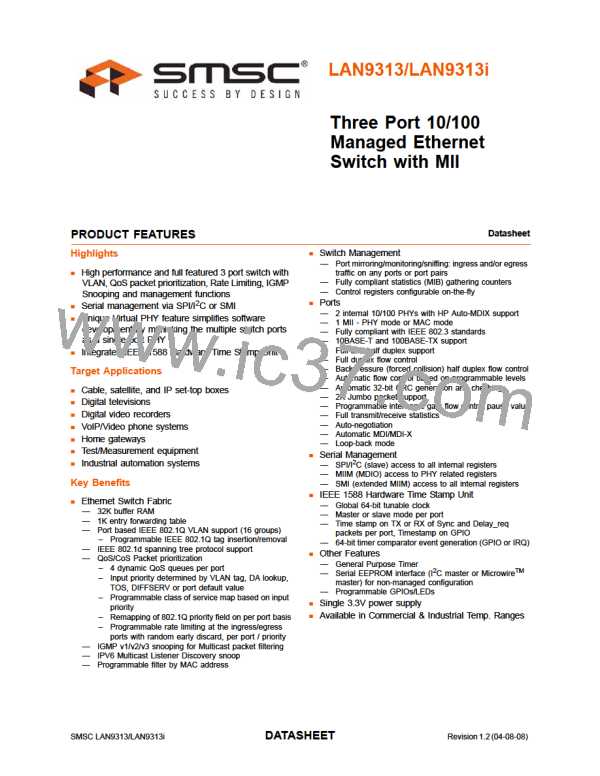Three Port 10/100 Managed Ethernet Switch with MII
Datasheet
controller drives all the address bits as requested regardless of the actual size of the EEPROM. The
supported size ranges for I2C operation are shown in Table 8.2.
Table 8.2 I2C EEPROM Size Ranges
eeprom_size_strap[0]
# OF ADDRESS BYTES
EEPROM SIZE
EEPROM TYPES
0
1 (Note 8.1)
16 x 8 through 2048 x 8
24xx00, 24xx01, 24xx02,
24xx04, 24xx08, 24xx16
1
2
4096 x 8 through 65536 x 8 24xx32, 24xx64, 24xx128,
24xx256, 24xx512
Note 8.1 Bits in the control byte are used as the upper address bits.
The I2C master interface runs at the standard-mode rate of 100KHz and is fully compliant with the
Philips I2C-Bus Specification. Refer to the he Philips I2C-Bus Specification for detailed timing
information.
2
8.2.2.1
I C Protocol Overview
I2C is a bi-directional 2-wire data protocol. A device that sends data is defined as a transmitter and a
device that receives data is defined as a receiver. The bus is controlled by a master which generates
the EE_SCL clock, controls bus access, and generates the start and stop conditions. Either the master
or slave may operate as a transmitter or receiver as determined by the master.
The following bus states exist:
Idle: Both EE_SDA and EE_SCL are high when the bus is idle.
Start & Stop Conditions: A start condition is defined as a high to low transition on the EE_ SDA
line while EE_ SCL is high. A stop condition is defined as a low to high transition on the EE_SDA
line while EE_SCL is high. The bus is considered to be busy following a start condition and is
considered free 4.7uS/1.3uS (for 100KHz and 400KHz operation, respectively) following a stop
condition. The bus stays busy following a repeated start condition (instead of a stop condition).
Starts and repeated starts are otherwise functionally equivalent.
Data Valid: Data is valid, following the start condition, when EE_SDA is stable while EE_SCL is
high. Data can only be changed while the clock is low. There is one valid bit per clock pulse. Every
byte must be 8 bits long and is transmitted msb first.
Acknowledge: Each byte of data is followed by an acknowledge bit. The master generates a ninth
clock pulse for the acknowledge bit. The transmitter releases EE_SDA (high). The receiver drives
EE_SDA low so that it remains valid during the high period of the clock, taking into account the
setup and hold times. The receiver may be the master or the slave depending on the direction of
the data. Typically the receiver acknowledges each byte. If the master is the receiver, it does not
generate an acknowledge on the last byte of a transfer. This informs the slave to not drive the next
byte of data so that the master may generate a stop or repeated start condition.
Revision 1.2 (04-08-08)
104
SMSC LAN9313/LAN9313i
DATASHEET

 SMSC [ SMSC CORPORATION ]
SMSC [ SMSC CORPORATION ]